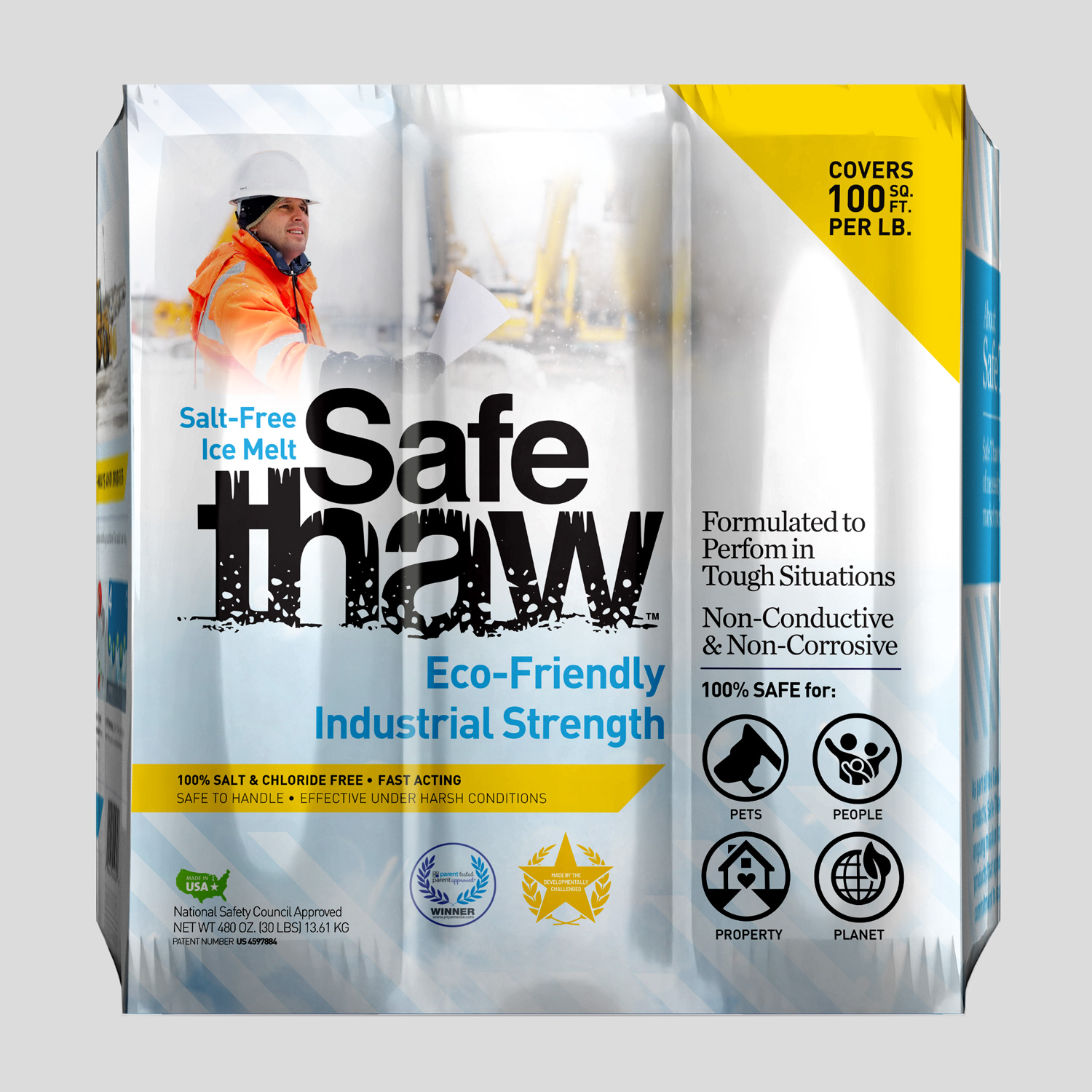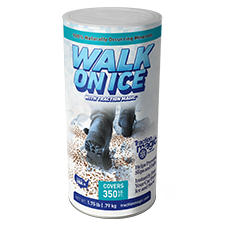How Long Does It Take For Salt To Melt Ice? Understanding The Melting Process

So, How Long Does It Take for Salt to Melt Ice?
As winter blankets our surroundings with frosty white landscapes, we often turn to the old, tried-and-true method of de-icing: salt. But how long does it take for salt to melt ice? The answer is not as straightforward as you might think. It depends on several factors, including the quantity of salt used, the temperature, and the thickness of the ice.
Salt, or sodium chloride, lowers the freezing point of water. When spread over ice, it creates a brine solution, which can melt the ice even at sub-zero temperatures. The reaction begins almost immediately, but the complete process may take a few hours depending on the aforementioned conditions.

Safe Thaw
Safe Thaw was created as the ice management solution for tough winter environments. Ideal in commercial and industrial properties, shops, government agencies, bridges, and construction.
At What Temperature Does Salt Stop Melting Ice?
Although salt is effective at melting ice, there’s a limit to its powers. At what temperature does salt stop melting ice? Sodium chloride can lower the freezing point of water to about -9 degrees Celsius (15.8 degrees Fahrenheit). Below this temperature, salt becomes ineffective at melting ice, which is why in extremely cold regions, other substances like calcium chloride or magnesium chloride are used, as they can lower the freezing point even further.
The Hidden Costs Of Using Salt For De-Icing
However, the question shouldn’t just be “how long does it take for salt to melt ice?” but also “what are the consequences of using salt for de-icing?” Salt’s corrosive nature can wreak havoc on our roads, vehicles, and infrastructure. It speeds up rusting and erosion, leading to hefty repair and replacement costs.
Furthermore, when the snow melts, the salt is washed away into our water bodies, disrupting aquatic ecosystems by raising salinity levels. It can also permeate the soil, affecting plant growth and agriculture. Not to mention, salt poses a health hazard for our pets, who can ingest it when they lick their paws, potentially leading to sodium ion poisoning.
Understanding The Ice Melting Point Celsius In Real Conditions
So, if salt has its limits, what about the ice melting point Celsius in general? Pure ice, without any additives, melts at 0°C. Pretty simple, right? But once you introduce salt—or any other compound—the story changes. The melting point of ice with salt drops well below 0°C, which is why salt has been used for so long.
Here’s the catch: it doesn’t always guarantee quick results. If you’re staring at a thick sheet of ice on your driveway at -8°C, sprinkling salt might only scratch the surface. That’s why in harsher climates, people often wonder: “Do I just keep dumping salt, or is there a better way?” Spoiler: piling on more salt isn’t always the fix. Instead, the solution lies in knowing both the science and safer alternatives that don’t leave long-term damage.
What’s The Melting Point Of Ice And Why Does It Matter For Safety?
You might ask, “What’s the melting point of ice, and why does it matter for me shoveling snow at 7 a.m.?” Well, here’s why. Knowing the temperature threshold where ice naturally turns to water helps you understand why certain products stop working. At 0°C (32°F), ice should start melting on its own. Additives like salt push that melting point lower, but only to a limit. Once the air temperature drops beyond salt’s capability—around -9°C—melting halts.
This is the moment when most people start scrambling for stronger chemicals like magnesium chloride. But here’s the real question: are these alternatives any safer? Not really. They might work at lower temperatures, but they come with their own baggage—erosion, toxic runoff, and harm to pets and vegetation. That’s why more property owners are waking up to the need for chloride-free products that work consistently without damaging what’s around them.
Concrete Melting Point Fahrenheit And The Risk You Don’t Think About
Another question that doesn’t get asked enough is this: “What about the concrete itself—doesn’t it have a limit?” Absolutely. The concrete melting point Fahrenheit isn’t the same as ice—it’s incredibly high, over 2,700°F. So no, your driveway isn’t literally melting in the heat or from salt. But here’s where the problem lies: repeated exposure to chlorides and freeze-thaw cycles breaks down concrete long before it ever reaches that extreme temperature.
Think of it like this: every time salty brine seeps into the tiny pores of your concrete, it expands and contracts as temperatures fluctuate. That cycle weakens the structure bit by bit until cracks appear. Add in steel reinforcement rods in bridges or sidewalks, and the corrosion accelerates. The result? Costly repairs and a surface that crumbles years sooner than it should.
So, while we often obsess over the ice, maybe we should be asking: “What’s really taking the bigger hit—the snow on top or the concrete below?”
The Real Lesson Behind The Melting Point Of Ice With Salt
Let’s circle back to the melting point of ice with salt for a moment. Yes, the science is clear—it lowers the freezing point. But the bigger lesson is this: every “quick fix” has a trade-off. You gain temporary safety on your steps, but you may be sacrificing your soil health, your garden, your pet’s well-being, and the lifespan of your driveway.
So, what’s the smarter question to ask in winter? Instead of only focusing on “How long does it take for salt to melt ice?”, maybe we should be asking: “How can I keep my surfaces safe without paying for it later?” That’s exactly where modern, chloride-free ice melts step in—they don’t just fight the ice; they protect everything else you care about too.
100% salt & chloride-free, fast acting Ice Management Solution
Conclusion
Looking at the big picture, the science of ice melting point Celsius or the concrete melting point Fahrenheit is more than trivia—it’s insight into why our choices matter every winter. Salt and its cousins may deliver a temporary fix, but the long-term damage tells another story. By understanding the melting point of ice with salt, we can see why the traditional approach fails to hold up in the face of today’s environmental and safety concerns.
So, what’s the takeaway? Ice will always melt; that’s science. But how we choose to make it melt—that’s strategy. You don’t have to gamble with cracked driveways, rusting cars, or sick pets just to get a clear path. Chloride-free solutions like Safe Thaw give us the chance to rethink what “winter readiness” should mean. It’s not just about surviving the storm; it’s about preserving the world around us while staying safe.
Next time you head outside with a shovel in one hand and a bag of ice melt in the other, pause and ask: is this choice melting only the ice, or is it slowly eating away at everything else I value? That little question may be the difference between a safe step today and a safer, healthier environment for years to come.
Try Also Our Other Winter Safety Products:
Safe Paw
The Original and #1 Selling Pet and Child Safe Ice Melt for over 20 years. Guaranteed environmentally safe –It won’t harm animals or children, and it won’t damage your property. That’s Safe Paw. Safe Paw can change how winter affects our planet.

Walk On Ice
The handy disposable canister can be taken everywhere, with the same 100% naturally occurring minerals that provide instant traction on ice or snow. Use it on sidewalks, steps, or as an instant traction agent for your car.



